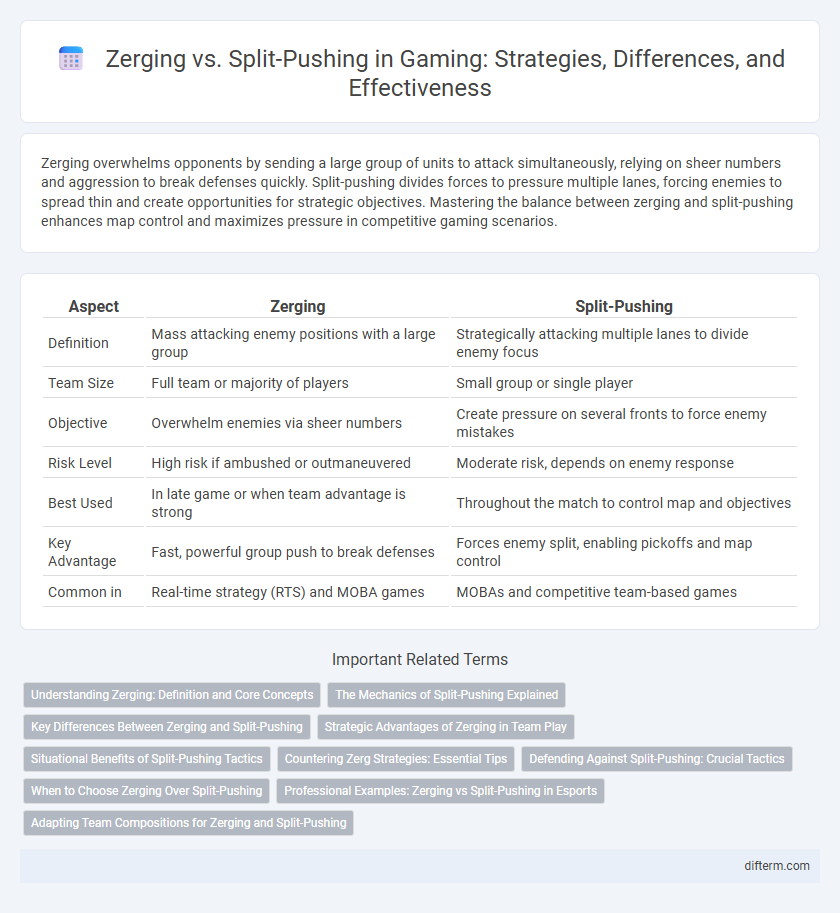Zerging overwhelms opponents by sending a large group of units to attack simultaneously, relying on sheer numbers and aggression to break defenses quickly. Split-pushing divides forces to pressure multiple lanes, forcing enemies to spread thin and create opportunities for strategic objectives. Mastering the balance between zerging and split-pushing enhances map control and maximizes pressure in competitive gaming scenarios.
Table of Comparison
| Aspect | Zerging | Split-Pushing |
|---|---|---|
| Definition | Mass attacking enemy positions with a large group | Strategically attacking multiple lanes to divide enemy focus |
| Team Size | Full team or majority of players | Small group or single player |
| Objective | Overwhelm enemies via sheer numbers | Create pressure on several fronts to force enemy mistakes |
| Risk Level | High risk if ambushed or outmaneuvered | Moderate risk, depends on enemy response |
| Best Used | In late game or when team advantage is strong | Throughout the match to control map and objectives |
| Key Advantage | Fast, powerful group push to break defenses | Forces enemy split, enabling pickoffs and map control |
| Common in | Real-time strategy (RTS) and MOBA games | MOBAs and competitive team-based games |
Understanding Zerging: Definition and Core Concepts
Zerging refers to overwhelming opponents with large groups of low-cost units to gain map control and force enemy responses in real-time strategy games like StarCraft. This strategy emphasizes rapid production, swarm tactics, and continuous aggression to exploit numerical superiority. Mastery of Zerging involves balancing unit economics, timing attacks, and map awareness to outmaneuver opponents before they can adapt.
The Mechanics of Split-Pushing Explained
Split-pushing in gaming involves strategically dividing your forces to apply pressure on multiple lanes simultaneously, forcing opponents to respond and creating opportunities for map control and objectives. This tactic requires precise map awareness, efficient resource management, and timing to maximize effectiveness while minimizing vulnerability to ambushes. Unlike zerging, which relies on overwhelming opponents with sheer numbers, split-pushing capitalizes on mobility and strategic lane pressure to disrupt enemy formations and gain tactical advantages.
Key Differences Between Zerging and Split-Pushing
Zerging relies on overwhelming opponents with large groups of units simultaneously, emphasizing sheer numbers and fast group movements to secure objectives and map control. Split-pushing involves strategically distributing forces across multiple lanes to pressure the enemy, forcing them to divide their attention and defenses, often creating opportunities for ambushes or objective captures. Key differences rest in group dynamics--zerging clusters forces for direct aggression, while split-pushing maximizes map pressure through simultaneous, dispersed threats.
Strategic Advantages of Zerging in Team Play
Zerging offers overwhelming numerical superiority, enabling teams to quickly secure objectives and control key map areas. Coordinated mass attacks disrupt enemy formations, reduce individual vulnerabilities, and maximize collective damage output. This strategy excels in maintaining pressure and forcing opponents into reactive play, capitalizing on teamwork and momentum in competitive gaming scenarios.
Situational Benefits of Split-Pushing Tactics
Split-pushing tactics excel in creating map pressure by forcing multiple opponents to respond, enabling teams to secure objectives or gain vision control with reduced risk. This strategy thrives in scenarios where the team excels at 1v1 duels and can swiftly retreat, leveraging advantageous positioning and superior mobility. Unlike zerging, which relies on overwhelming force, split-pushing exploits enemy mismanagement and map awareness, making it ideal for teams aiming to control tempo and objectives strategically.
Countering Zerg Strategies: Essential Tips
Countering zerg strategies requires early map control and vision to anticipate overwhelming attacks. Focus on splitting your forces strategically to avoid being swarmed by mass units, while targeting key zerg expansions to cripple their economy. Efficient unit positioning and harassment disrupt their momentum, forcing them into defensive play.
Defending Against Split-Pushing: Crucial Tactics
Defending against split-pushing in gaming requires precise map awareness and effective use of vision to track enemy movements. Applying timely rotations and grouping forces at critical objectives prevents opponents from gaining uncontested map control. Utilizing heroes with strong wave-clear abilities and teleportation skills can disrupt split-push strategies and protect key structures from being taken down.
When to Choose Zerging Over Split-Pushing
Zerging is most effective in games like real-time strategy or MOBAs when overwhelming opponents with sheer numbers can quickly secure objectives or control key map areas. Choose zerging when your team has superior unit production or reinforcements to maintain constant pressure, forcing enemies to defend multiple threats simultaneously. This strategy excels in early to mid-game phases where rapid, synchronized attacks can disrupt enemy economies and prevent them from regrouping.
Professional Examples: Zerging vs Split-Pushing in Esports
Professional esports teams deploy zerging strategies in games like StarCraft II and League of Legends to overwhelm opponents with rapid, concentrated attacks, exemplified by Team Liquid's aggressive StarCraft II playstyle. Conversely, split-pushing is effectively used by teams such as Fnatic in League of Legends, exploiting map pressure to create multiple threats and force enemy rotations. Both strategies require precise coordination and map awareness to maximize territorial control and objective advantage in competitive gaming.
Adapting Team Compositions for Zerging and Split-Pushing
Effective team compositions for Zerging emphasize heavy crowd control and burst damage champions to overwhelm opponents quickly, leveraging wave-clear abilities to maintain pressure. Split-pushing strategies require agile, high-mobility champions with strong dueling potential, allowing players to apply pressure on side lanes while the team controls objectives elsewhere. Balancing these compositions involves selecting champions that can transition between grouped team fights and isolated skirmishes, ensuring flexibility in dynamic game scenarios.
Zerging vs Split-pushing Infographic

 difterm.com
difterm.com